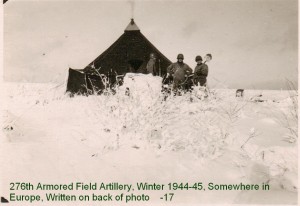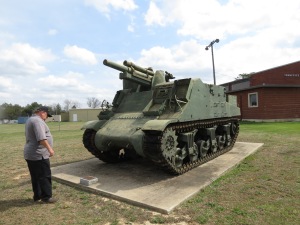Due to the interest generated by my post about the M7 Priest, I decided to write about my father-in-law’s unit and their experiences during the war.
The Battalion
The 276th Armored Field Artillery Battalion was in the European Theatre of Operation combat zone for 241 days, from September 1944 until the Germans surrendered in May 1945. They fought in the Battle of Northern France, the Battle of the Rhineland, the Battle of the Bulge, and the Battle for Central Europe. From the first round fired at Andelot, France, (near Nancy) they moved across Europe to near Strakonice, Czechoslovakia, at the war’s end. The battalion’s eighteen guns fired approximately 90,000 rounds in combat and provided support to whoever needed their guns. Thus they supported numerous groups including the French Second Armored Division, the Third Army, the 80th Infantry Division, the 6th Armored Division, the 12th Armored Division, the 9th Armored Division, the 4th Armored Division, the 90th Infantry Division, the 5th Infantry Division, the 26th Infantry Division, and the 11th Armored Division.

The 276th started out in Kansas where they trained as a field artillery battalion. While on maneuvers in Tennessee orders came to reorganize the battalion into an armored field artillery battalion. In January, 1944, they reported to Camp Campbell, Ky., for retraining on M7 track-mounted 105 howitzers.

On June 23 they left for Camp Shanks, New York, where they boarded the SS John Ericsson, set sail on July 1, 1944, and crossed the Atlantic to England. After arriving at Liverpool, they proceeded by train to Lianmartin, Monmouthshire, South Wales, for a thirty-day readying period.
The Campaign in Lorraine
On August 20th the battalion moved to Weymouth, on the south coast, and loaded on LST’s to cross the channel. After landing on Utah Beach in Normandy, the 276th began the motor march across France. By September 10 they reached Joinville, in eastern France near Nancy, where they were assigned to the French Second Armored Division. Here they fired their first combat rounds in the war.

Over the next few days the 276th crossed the Moselle and Meurthe rivers still in support of the French. During September and into October the account of engagements and movements reads like a tour guide of villages in Lorraine. Members of the battalion were killed, wounded and a few were captured. During a short rest the men stayed in French villages where the citizens welcomed them as liberators. From late October through mid-November, the 276th supported the 6th Armored Division defending Landroff from a strong enemy counter-attack. Steady rain in November caused muddy roads, traffic jams, hampered operations and generally made life miserable for the men. On December 5 they fired into Germany for the first time.
In early December orders came transferring 10% of the enlisted men, or 48 men, to the infantry. Assigned to support the 80th Infantry Division, the 276th continued to fight along the German border. But on December 20th orders changed.
Battle of the Bulge
As part of Patton’s Third Army, the 276th journeyed from near Bettviller in easternmost France to the City of Luxembourg in four days, enduring snow, extreme cold, and icy, mountainous roads. This was the famous march in the dead of winter that Third Army made to relieve the US troops surrounded at Bastogne. In Luxembourg the 276th moved further north to engage the enemy along the southern shoulder of the bulge where they spent Christmas of 1944. During this time the weather was extremely cold. They were not allowed to build fires and they had no hot food. My father-in-law said that one night he fell asleep under the gun and when awakened by gunfire he was numb and stiff. Had he not awakened, he would have frozen to death, as many did that winter.

In the movie “Patton” there is a scene where General George S. Patton ordered a chaplain to write a prayer for good weather so that they could attack. This actually happened. The successful results of this prayer impressed Patton so much that he had a copy of it sent to all the men in Third Army. My father-in-law sent it to his mother who gave it to my husband. The prayer is printed on both front and back of a small, thin piece of paper about the size of a baseball card.
In January the 276th still supported the 80th Infantry Division as they fought northward helping the 319th Inf. Regiment repel a strong counter-thrust near Nocher. The battle remained near Heiderscheid until Jan. 18. when the battalion supported attacks on Dahl and Kaulenbach, Luxembourg. By the end of January the Allies had crushed German offensive and had pushed back the battle lines to roughly where they had been in early December.
In February the battalion hammered the Siegfried Line along the Luxembourg-German border. They established liaison with the 4th Armored Division protecting the flanks of the 80th. Targets for the thousands of rounds fired included German defensive positions with nebelwerfers (rockets called screaming meme’s), mortars, tanks, pill boxes, snipers, infantry, vehicles and gun batteries. They crossed the Sauer river near Cruchten into Germany on February 20. Five days later the 276th received orders transferring them to support of the 4th Armored Division and continued to move further into German territory.
In Part 2 I will continue to recount the experiences of the 276th in the last months of the war in Europe.
Thanks to Teresa Williams for allowing me to use her father’s photos. Her father is Morris I. Grayson, Battery “B”, 276th Armored Field Artillery Battalion. Details were taken from the history of the 276th Armored Field Artillery Battalion compiled by Sgt. Bruce B. Palmer.
 Colonel Ray Hosley Smith, originally of Shinglehouse, PA, retired in 1973 after an illustrious career in the U. S. Army. At his death in 2013, he was buried in Arlington National Cemetery. Col. Smith started his military service as a Second Lieutenant in the 276th Armored Field Artillery Battalion during WWII.
Colonel Ray Hosley Smith, originally of Shinglehouse, PA, retired in 1973 after an illustrious career in the U. S. Army. At his death in 2013, he was buried in Arlington National Cemetery. Col. Smith started his military service as a Second Lieutenant in the 276th Armored Field Artillery Battalion during WWII.











